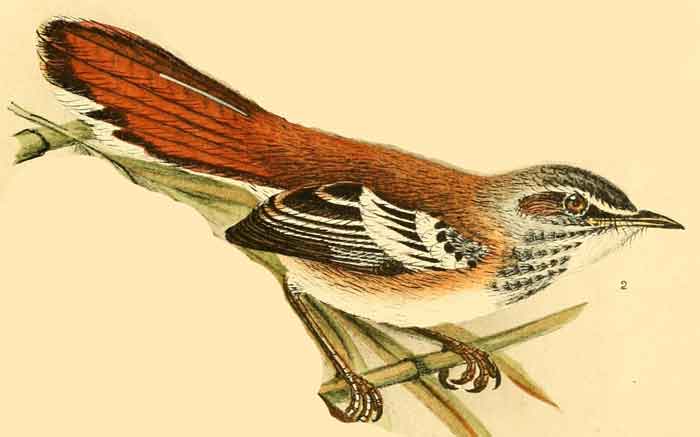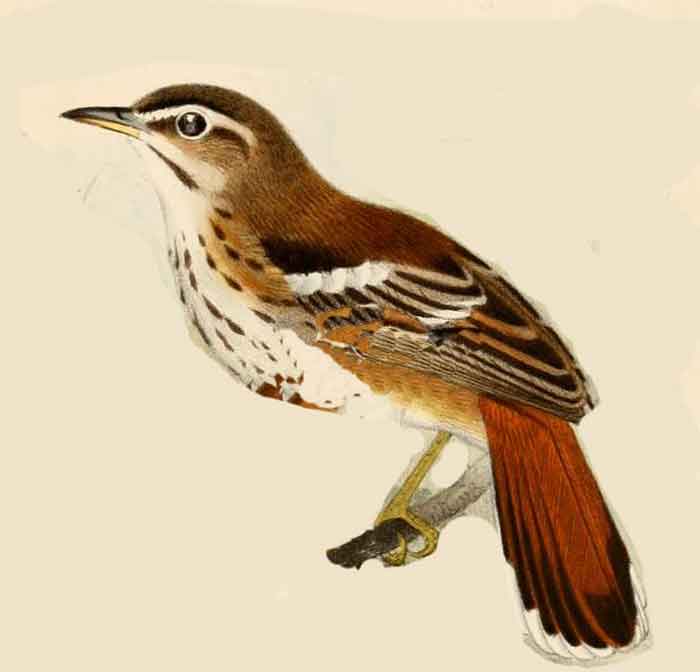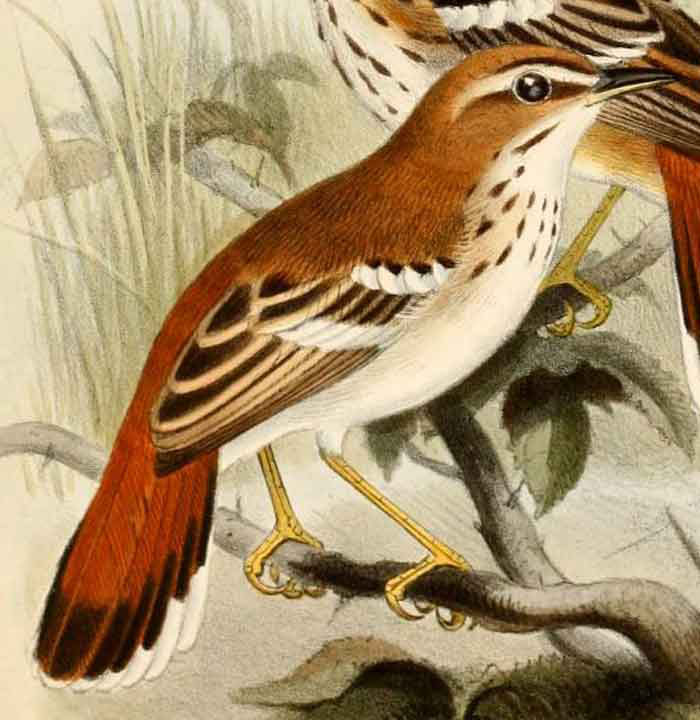
Cercotrichas leucophrys vulpina
Superregnum: Eukaryota
Cladus: Unikonta
Cladus: Opisthokonta
Cladus: Holozoa
Regnum: Animalia
Subregnum: Eumetazoa
Cladus: Bilateria
Cladus: Nephrozoa
Superphylum: Deuterostomia
Phylum: Chordata
Subphylum: Vertebrata
Infraphylum: Gnathostomata
Megaclassis: Osteichthyes
Cladus: Sarcopterygii
Cladus: Rhipidistia
Cladus: Tetrapodomorpha
Cladus: Eotetrapodiformes
Cladus: Elpistostegalia
Superclassis: Tetrapoda
Cladus: Reptiliomorpha
Cladus: Amniota
Classis: Reptilia
Cladus: Eureptilia
Cladus: Romeriida
Subclassis: Diapsida
Cladus: Sauria
Infraclassis: Archosauromorpha
Cladus: Crurotarsi
Divisio: Archosauria
Cladus: Avemetatarsalia
Cladus: Ornithodira
Subtaxon: Dinosauromorpha
Cladus: Dinosauriformes
Cladus: Dracohors
Cladus: Dinosauria
Cladus: Saurischia
Cladus: Eusaurischia
Subordo: Theropoda
Cladus: Neotheropoda
Cladus: Averostra
Cladus: Tetanurae
Cladus: Avetheropoda
Cladus: Coelurosauria
Cladus: Tyrannoraptora
Cladus: Maniraptoromorpha
Cladus: Maniraptoriformes
Cladus: Maniraptora
Cladus: Pennaraptora
Cladus: Paraves
Cladus: Eumaniraptora
Cladus: Avialae
Infraclassis: Aves
Cladus: Avebrevicauda
Cladus: Pygostylia
Cladus: Ornithothoraces
Cladus: Ornithuromorpha
Cladus: Carinatae
Parvclassis: Neornithes
Cohors: Neognathae
Cladus: Neoaves
Cladus: Telluraves
Cladus: Australaves
Ordo: Passeriformes
Subordo: Passeri
Infraordo: Passerida
Superfamilia: Muscicapoidea
Familia: Muscicapidae
Genus: Cercotrichas
Species: Cercotrichas leucophrys
Subspecies: C. l. brunneiceps – C. l. eluta – C. l. leucophrys – C. l. leucoptera – C. l. munda – C. l. ovamboensis – C. l. sclateri – C. l. vulpina – C. l. zambesiana
Name
Cercotrichas leucophrys (Vieillot, 1817)
Synonymy
Sylvia leucophrys (protonym)
References
Vieillot, L.P. 1817. Nouveau Dictionnaire d’Histoire naturelle, appliquée aux arts, à l'agriculture, à l'économie rurale et domestique, à la médecine, etc. Par une société de naturalistes et d'agriculteurs. Avec des figures tirées des trois règnes de la nature. Tome 11. 602 pp. + 6 tt. Déterville, Paris. p. 191 BHLReference page.
Vernacular names
Afrikaans: Gestreepte wipstert
català: Cuaenlairat de carpó vermell
čeština: Pěvec pruhokřídlý
Cymraeg: Robin prysgoed fannog
dansk: Plettet Trænattergal
Deutsch: Weißbrauen-Heckensänger
English: White-browed Scrub Robin
español: Alzacola dorsirrojo
eesti: Akaatsia-võsaööbik
suomi: Viiruruostepyrstö
français: Agrobate à dos roux
hrvatski: Pjegavoprsi živičnjak
magyar: Barnásfehér tüskebujkáló
italiano: Usignolo dorsorosso
日本語: フタスジヤブコマドリ
lietuvių: Baltasparnė krūmyninė liepsnelė
Nederlands: Witbrauwwaaierstaart
norsk: Hvitbrynkrattskvett
polski: Drozdówka jasna
português: Rouxinol-do-mato-estriado
русский: Белокрылый тугайный соловей
slovenčina: Žltorítka savanová
svenska: Vitbrynad trädnäktergal
українська: Альзакола білоброва

Cercotrichas leucophrys munda

Cercotrichas leucophrys zambesiana
The white-browed scrub robin (Cercotrichas leucophrys), also known as the red-backed scrub-robin, is a species of bird in the family Muscicapidae. It is native to sub-Saharan Africa, especially East and southern Africa. Within range, its Turdus-like song is one of the often-heard sounds of the bush. The flitting of the tail is characteristic of this species, but also of some near relatives.
Taxonomy
Louis Pierre Vieillot described the white-browed scrub robin in 1817. The specific epithet is derived from the Ancient Greek words leukos "white" and ǒphrys "eyebrow".[2]
Subspecies
front: E. l. zambesiana Sharpe, 1882,
back: E. l. munda (Cabanis, 1880), illustrated by Joseph Smit Note: yellow leg colour inaccurate
For the white-browed scrub robin, some 9 to 12 subspecies are recognized:[3][4] Two groups of subspecies are recognised, namely the 'white-winged' group of arid country, and the 'red-backed' group of mesic to moist habitats.[4] Intergradation between these is apparently limited to subspecies brunneiceps and vulpina around Simba, Kenya. Otherwise the variation is clinal, though the extremes may be quite distinct.[5]
'White-winged' group
C. l. leucoptera (Rüppell, 1845) – arid woodlands, from South Sudan to Lake Turkana and Horn of Africa
C. l. eluta (Bowen, 1934) – dry woodlands, from Ethiopia to s Somalia and Tana River, Kenya
C. l. vulpina (Reichenow, 1891) – dry woodlands of eastern Kenyan and Tanzanian interior
'Red-backed' group
C. l. brunneiceps (Reichenow, 1891) – along Rift valley and Crater Highlands to Mt Meru
C. l. sclateri (Grote, 1930) – Mbulu Highlands to Tarangire in Tanzanian interior
C. l. zambesiana (Sharpe, 1882) – West of Rift Valley and along Great Lakes to east coast (South Sudan to central Mozambique)
C. l. munda (Cabanis, 1880) – southern Gabon to central Angola
C. l. ovamboensis (Neumann, 1920) – parts of Angola, Namibia, Zambia and Zimbabwe
C. l. leucophrys (Vieillot, 1817) – southern Zimbabwe and Mozambique to southern South Africa
Following Clancey, the nominate subspecies is sometimes restricted to the Eastern Cape region, and the following subspecies are then distinguished from it:[6]
C. l. pectoralis (A.Smith, 1836) – southern Zimbabwe, eastern Botswana and northern South Africa
C. l. simulator Clancey, 1964 – southern Mozambique and Eswatini
C. l. streptitans Clancey, 1975 – KwaZulu-Natal
Description
The white-browed scrub robin measures 14.0–16.5 cm from bill tip to tail tip and the sexes are alike.[4] The pale superciliary stripe is distinct, and the crown may be warm brown, olive brown or greyish brown. The wings are dusky but well-marked. Greater and lesser wing coverts always white-tipped, but the secondaries with or without white edging. Amount of streaking on the breast is very variable, in subsp. ovamboensis it is reduced to fine streaking encircling the throat.[5] The breast and flanks are washed with a variable amount of tawny buff. The mantle and back is brownish to hazel or rufous, depending on the subspecies. The tail is greyish brown to rufous, with a black subterminal band and white feather tips and corners. Juveniles are mottled but with the tail pattern of adults.[4]
Distribution and habitat
The white-browed scrub robin is found in Angola, Botswana, Burundi, Republic of the Congo, DRC, Djibouti, Eswatini, Ethiopia, Gabon, Kenya, Malawi, Mozambique, Namibia, Rwanda, Somalia, South Africa, South Sudan, Tanzania, Uganda, Zambia, and Zimbabwe. Its range spans tropical, subtropical and temperate latitudes. It is present and usually common in any mesic to arid woodland or savanna, provided that there is cover, open scrub or thickets.[5] In the Eastern Highlands it is only present up to 1,400 metres, and in East Africa up to 1,500 metres.[4] It is replaced on the Kalahari sands by the Kalahari scrub robin,[5] while in the Horn of Africa it is sympatric with the rufous bush chat, which lacks any white in the wings. Suitable habitat is usually grassy, which facilitates nesting.
Behaviour
Visiting termite galleries
Duration: 22 seconds.0:22
C. l. pectoralis song in the northern Kruger National Park, South Africa
Sedentary except in the far south.[3] A restless but shy species which mostly sings from concealment inside bushes. It hops on the ground when foraging.[4] As with some other scrub robin species, the tail is regularly flicked and fanned, and the wings may be drooped. The alarm is a sharp skirr or skee-ip note. The loud and variable song may include countless, sometimes identical repetitions. The songs of the respective subspecies are believed to be distinguishable, and those of the 'white-winged' group are considered to be shriller.[4] It feeds on insects, especially termites and ants.[3]
Breeding
Pairs are monogamous and nest solitarily from early to midsummer. The nest is built from dry grass by the female only, and is placed some 10 to 20 cm up at the heart of a grass tuft.[7] Usually three eggs are laid and these are incubated by the female only. The cream-coloured eggs, measuring 20 x 14 mm, are blotched with brown and purple around the thicker end. The chicks are reared by both parents. Some nests are parasitised by cuckoos.
References
BirdLife International (2016). "Cercotrichas leucophrys". IUCN Red List of Threatened Species. 2016: e.T22709927A94228013. doi:10.2305/IUCN.UK.2016-3.RLTS.T22709927A94228013.en. Retrieved 11 November 2021.
Liddell, Henry George; Scott, Robert (1980). A Greek-English Lexicon (abridged ed.). London: Oxford University Press. ISBN 0-19-910207-4.
Collar, N. (2018). "White-browed Scrub Robin (Cercotrichas leucophrys)". Handbook of the Birds of the World Alive. Lynx Edicions, Barcelona. Retrieved 12 March 2018.
Zimmerman, Dale A.; et al. (1999). Birds of Kenya and Northern Tanzania. Princeton University Press. pp. 236, 541–542. ISBN 0691010226.
Irwin, Michael P. Stuart (1981). The birds of Zimbabwe. Salisbury, Zimbabwe: Quest Pub. pp. 276–277. ISBN 0-86925-156-2.
Chittenden, H.; et al. (2012). Roberts geographic variation of southern African birds. Cape Town: JVBBF. pp. 204–205. ISBN 978-1-920602-00-0.
Tarboton, Warwick (2001). A Guide to the Nests and Eggs of Southern African Birds. Cape Town: Struik. p. 179. ISBN 1-86872-616-9.
Retrieved from "http://en.wikipedia.org/"
All text is available under the terms of the GNU Free Documentation License

